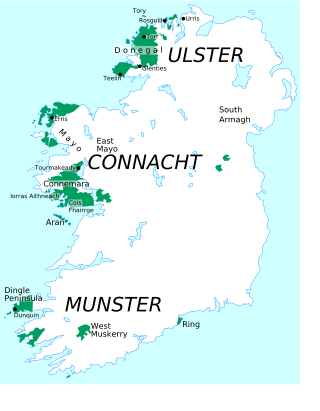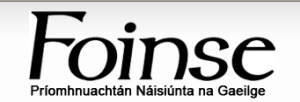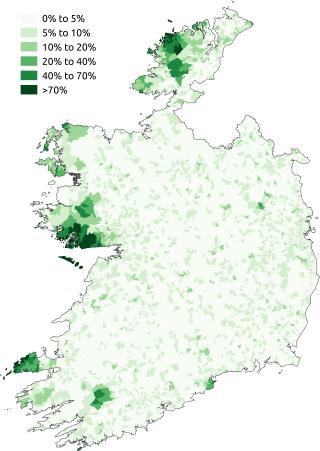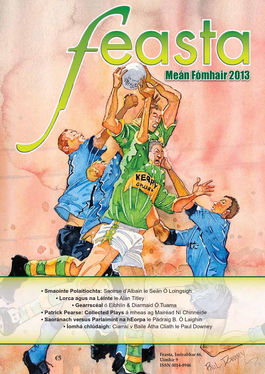Conradh na Gaeilge is a social and cultural organisation which promotes the Irish language in Ireland and worldwide. The organisation was founded in 1893 with Douglas Hyde as its first president, when it emerged as the successor of several 19th century groups such as the Gaelic Union. The organisation was a spearhead of the Gaelic revival and of Gaeilgeoir activism.

Gaeltacht are the districts of Ireland, individually or collectively, where the Irish government recognises that the Irish language is the predominant vernacular, or language of the home. The Gaeltacht districts were first officially recognised during the 1920s in the early years of the Irish Free State, following the Gaelic revival, as part of a government policy aimed at restoring the Irish language.
Although Irish has been used as a literary language for more than 1,500 years, and modern literature in Irish dates – as in most European languages – to the 16th century, modern Irish literature owes much of its popularity to the 19th century Gaelic Revival cultural movement. Writers in Irish have since produced some of the most interesting literature to come out of Ireland, supplemented by work produced in the language abroad.

Foinse was an Irish-language newspaper in Ireland. It was first published October 1996 and had both print and online editions until September 2013 when its publisher, Móinéar Teo, announced that it would become online only from that month. The Foinse website continued to be active until 2015 when it was shut down.
Eoghan Ó Tuairisc was an Irish poet and writer.
An Gúm was an Irish state company tasked with the publication of Irish literature, especially educational materials. The agency is now part of Foras na Gaeilge. Its mission statement is "To produce publications and resources in support of Irish-medium education and of the use of Irish in general." It is the largest publisher of books in Irish in the country. Seosamh Ó Murchú is the current Senior Editor.
Tearma.ie is the website of a lexical database for terminology in the Irish language. It is funded by the Irish state and Interreg and maintained by Fiontar & Scoil na Gaeilge, the Irish-language unit of Dublin City University, in collaboration with the Terminology Committee of Foras na Gaeilge.

The Irish Wikipedia is the Irish-language version of Wikipedia, run by the Wikimedia Foundation and established in October 2003, with the first article being written in January 2004. The founder of Vicipéid was Gabriel Beecham. In September 2005 over 1600 articles had been written, with 173 contributors having written material. By March 2007, about 20 regular Wikipedians were writing articles, with up to 7,000 articles having been created. In February 2021, it was just under the 55,000 article mark, making it the 94th largest Wikipedia by article count.

Raidió na Life 106.4FM is an Irish-language radio station founded in 1993 and broadcasting in County Dublin, Ireland. In addition to being transmitted on FM, the station's output is available worldwide via the internet.

Irish, also known as Gaelic, is a Goidelic language of the Insular Celtic branch of the Celtic language family, which is a part of the Indo-European language family. Irish is indigenous to the island of Ireland and was the population's first language until the 19th century, when English gradually became dominant, particularly in the last decades of the century. Today, Irish is still commonly spoken as a first language in areas of Ireland collectively known as the Gaeltacht, in which only 2% of Ireland's population lived in 2016. It is also spoken by a larger group of habitual but non-traditional speakers, mostly in urban areas where the majority are second-language speakers.
Saol ("Life") – full title Saol na Gaeilge – is an Irish-language monthly newspaper supported by Foras na Gaeilge, the public body responsible for the promotion of the language throughout the island of Ireland. Printed on the presses of the Connacht Tribune in Galway, the newspaper has its headquarters in Dublin.

Acadamh na hOllscolaíochta Gaeilge is a third level educational and research institution headquartered in Galway, Ireland. It was established as part of the University of Galway in 2004, to further the development Irish-medium education. The academy works in co-operation with faculties, departments and other university offices to develop the range and number of programmes that are provided through the medium of Irish on campus and in the academy's Gaeltacht centres.

The official status of the Irish language has remained high in the Republic of Ireland from foundation. This reflects the dominance of the language in Irish cultural and social history until the nineteenth century and its role in Irish cultural identity. In 2022, strong recognition was added in Northern Ireland also. In April 2016, as much as 1,761,420 people in the Republic said that they could speak Irish, representing 39.8 percent of respondents out of a population of 4,921,500. In Northern Ireland 104,943 said that they were able to speak Irish out of a population of 1,882,000. It has been found, however, that while ideological support for Irish is high, actual routine use is very low, and that there is no correlation between personal fluency in the language and the perceived value of Irish as an identity-marker. Nevertheless, the language benefits from the support of activists who continue to use it as a social and cultural medium.

Feasta is an Irish-language magazine that was established in 1948. Its purpose is the furtherance of the aims of Conradh na Gaeilge, an objective reflecting the cultural nationalism of the language movement, and the promotion of new writing. Feasta describes itself as a review of Irish thought, literature, politics, and science. It was formerly supported by Foras na Gaeilge, but this support was withdrawn because of a review of funding priorities. At present the magazine relies on its own resources.
Rónán Mac Con Iomaire is the Director of Regional & Community Development & Language with Údarás na Gaeltachta and is an Irish author and broadcaster.

Cois Fharraige, previously spelled Cois Fhairrge, is a coastal area west of Galway city, where the Irish language is the predominant language. It stretches from Na Forbacha, Bearna, An Spidéal to Indreabhán. There are between 8,000 and 9,000 people living in this area.
Eoin Ó Murchú is a writer and retired journalist in both Irish and English, a political activist and a former member of Official Sinn Féin/the Workers' Party, and the Communist Party of Ireland.
Máirín Nic Eoin, Irish academic and scholar.
Gaeloideachas is a national Irish organisation supporting the development of Irish-medium immersion schools at preschool and primary and secondary levels in the Republic of Ireland.








